SWOT might sound like a modern digital marketing acronym. But SWOT analysis has actually been used since the 1960s to guide strategic planning.
A social media SWOT analysis uses this established framework to guide your social media strategy. It looks at both internal and external factors to guide your social media plans.
Key Takeaways
- A social media SWOT analysis is a strategic planning tool used to evaluate social media performance by analyzing internal strengths and weaknesses, as well as external opportunities and Threats.
- A SWOT analysis helps social marketers sett realistic goals, identify risks, and stay ahead of industry trends.
- This framework is particularly useful for making budget decisions, launching new campaigns, and performing annual social media audits.
What is a social media SWOT analysis?
A SWOT social media analysis is a specific way of looking at your performance and understanding the climate in your industry and the social media sphere. SWOT stands for strengths, weaknesses, opportunities, and threats.
- Strengths. Things you’re doing well – in comparison to your own previous results and to the competition.
- Weaknesses. Areas where your brand could improve, from social media performance to resources to strategy.
- Opportunities. External factors that present a chance for your brand to excel, like the emergence of a new social media platform.
- Threats. External factors that could hurt how your content performs, like regulation or social media algorithm changes.
Strengths and weaknesses look at internal factors. These are things within your company that you can control. Opportunities and threats focus on external factors. These things happen outside of your company but still affect your strategy and goals. You can’t control them, but you need to be aware of them and understand how they will affect your work.
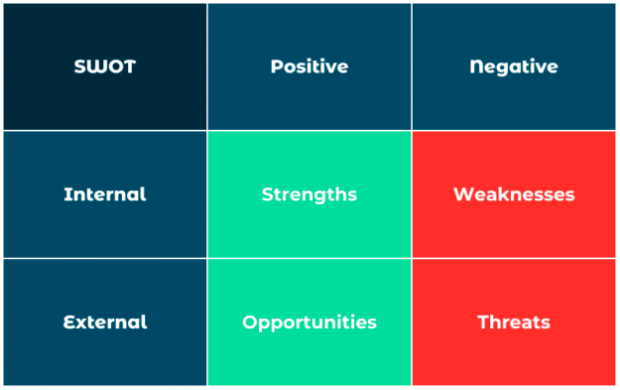
What can a SWOT analysis on social media do for you?
Help you set impactful (but realistic) goals
For goals to be effective, they need to be ambitious but achievable. To understand what’s possible, you need to understand both your own history of success and what’s happening in the social media world.
We’ve got separate blog posts to help you with the details of setting SMART goals and social media KPIs. A SWOT includes benchmarking and analysis to aid the goal-setting process.
Identify and mitigate risks
Weaknesses and threats might sound scary. But taking a detailed look at these areas will help you prepare for curveballs coming your way.
Weakness analysis helps you spot internal risks related to process, tools, teams, and so on. Meanwhile, threats analysis highlights potential risks. These may include compliance obligations, shifting cultural norms, or changes to the economy.
For example, 51% of consumers say they are likely to stop using a brand’s product or service if their ad appears near inappropriate content. And 72% believe brands are responsible for the content surrounding their ads.
How does this data impact a social media SWOT analysis? It highlights brand safety as a potential threat when creating social media ads. But identifying this threat means you can put strategies in place to mitigate the risk. For example, you can use risk tolerance tools within social ad platforms to adjust the types of content your ads may appear next to.
Risk management is an important part of your social media strategy. A SWOT analysis ensures you’re focused on the right risks at the right time.
Keep ahead of the curve
A social media SWOT analysis forces you to think beyond your own social media analytics. It considers the broader landscape and changes on the horizon, so you are always ahead of the game.
For example, most retail brands should look at holiday shopping patterns in their opportunities analysis for the latter half of the year.
New data from Civic Science shows that 28% of holiday shoppers had already begun holiday shopping in August of 2024. And 34% plan to start before Thanksgiving. These early shoppers present a clear opportunity for social media marketers. But only if you also get things moving early.
Civic Science also found that shoppers who use buy now, pay later plans are more likely to start holiday shopping earlier. If you want to encourage earlier shopping, there’s an opportunity to highlight that option in social campaigns. If you don’t yet offer these services, there’s an opportunity to test them out.
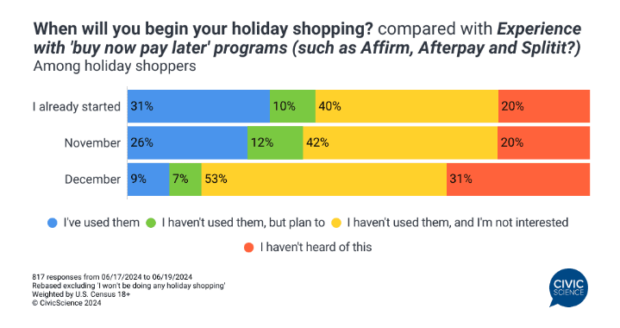
Source: Civic Science
Stay in touch with your performance
You already use social analytics to understand your performance and report to stakeholders.
But reporting in a bubble can give you a false sense of the possibilities. Conducting a SWOT analysis includes external data like industry benchmarking and competitor research. This reveals the true level of your success compared to your peers.
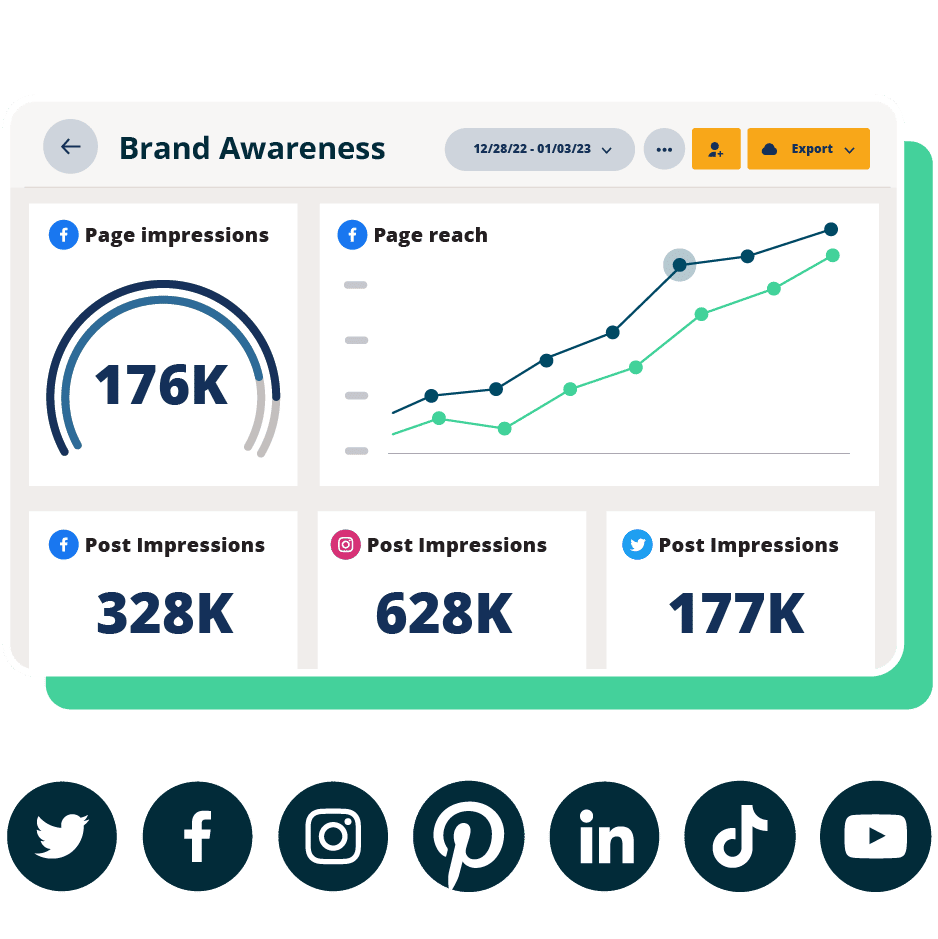
#1 Analytics Tool for Growth
Beautiful reports. Clear data. Actionable insights to help you grow faster.
Allocate resources effectively
Internal social media analysis only considers the strategies you already use. This is a good starting point for determining how to allocate your social media resources. But it misses out on all the strategies you have not yet tried.
A SWOT for social media takes things a step further by incorporating data from beyond your organization. For example, recent data from LinkedIn and Ipsos shows that 55% of B2B marketers say short-form social video has the highest ROI of any type of video.

Source: LinkedIn 2024 B2B Marketing Benchmark
If you’re a B2B marketer who’s not yet using short-form social videos, this presents a clear opportunity. This external information doesn’t guarantee short-form social videos will provide the best ROI for you. But it’s an indication that you should allocate some resources to test them out.
Look beyond social media
The information you gather from a social media SWOT analysis applies to departments across your brand. There are often particularly relevant insights for product development and customer service.
Pay particular attention here to weaknesses and threats. These areas provide the greatest opportunity to collaborate with other departments to course-correct.
For example, social media will likely be the source of some customer challenges and complaints. This is not all bad news! In fact, identifying common themes in negative social media feedback allows you to address the problem much faster than you ever could without social media analysis in place.
How to run a social media SWOT analysis
Now that you understand what you can gain from doing a social media SWOT analysis, let’s look at how to gather all the data you need.
Strengths
Data in the strengths quadrant of your SWOT for social media should focus on metrics where you’re performing well. Especially if you’re performing better than the competition.
Start by gathering your own metrics through social media analytics tools. Then take a look at the competition to see if you can understand where you’re outperforming.
Hootsuite’s industry benchmarking and competitive analysis features are really useful for getting an inside look at your competitors’ performance and how you stack up.

You can see how you compare against your industry as a whole based on profile impressions, audience growth rate, and post engagement rate. You can also see how you compare against specific competitors.
Looking at your social share of voice and measuring social sentiment are also important ways of understanding and measuring your success. Hootsuite Listening provides these important metrics for your social media SWOT analysis.
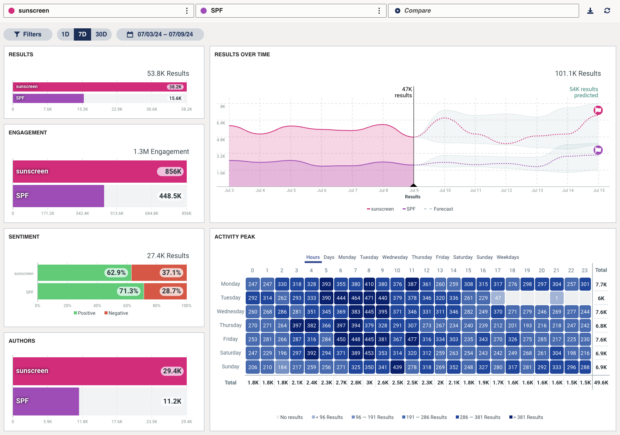
Weaknesses
The process and tools here are pretty much the same as identifying your social media strengths. Start with your own metrics. Compare your most recent results with results from previous social media campaigns or time periods. Then, benchmark yourself against the competition.
This will allow you to see where you’re falling short. You can also identify strategies that worked in the past but are no longer delivering the results you expect.
Get quite specific as you identify your weaknesses. You can’t just say you’re falling behind the competition on TikTok. You probably have some strengths and some weaknesses on every platform. Only by breaking them down in detail can you properly understand what to do next.
A dedicated social analytics tool like Hootsuite provides a full picture of your cross-platform performance. This reveals how engagement and conversions shift across your accounts over time.
Also take a broader look at your organization beyond the social media team. List any changes that have the potential to affect your social media presence. Have there been layoffs? Budget cuts? Maybe you’re recovering from a social media crisis?
Monitoring social sentiment can be particularly important here. It helps you understand the mood behind the mentions of your brand on social media. For example, high engagement numbers on a particular post or platform might initially look like a strength. But if your social sentiment is dropping, you might have uncovered a weakness in disguise.
Opportunities
Remember that opportunities and threats look at factors external to your organization. So, to look for opportunities, you need to make sure you have a firm understanding of what’s happening right now. That means looking at the overall economic/business climate and the social media world as well as your own industry niche.
Start by setting up a social listening program to monitor the competition. For example, if conversation volume around a specific keyword is on the rise, there’s opportunity to create content targeting that keyword and reach that active community.
Hootsuite Listening can help you spot both specific keywords and overall themes. Both present opportunities for new social content.
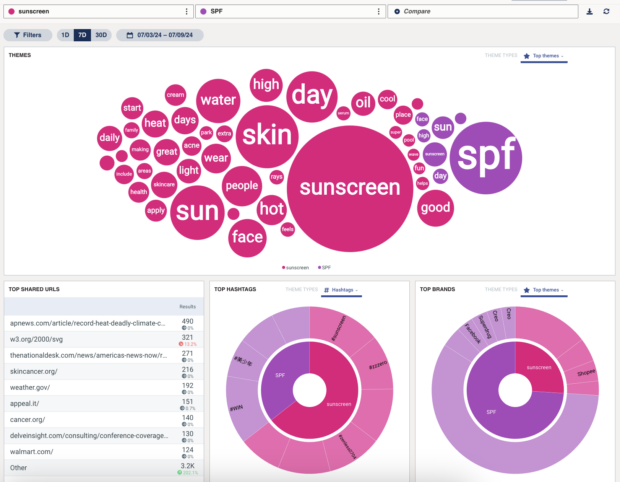
On the social media front, keep an eye on this blog and the Hootsuite social media channels. Both are good places to learn about new social developments that might present opportunities for your brand.
Our annual Social Media Trends report is a particularly useful read here.
Threats
Just like opportunities, threats are external factors. So, again, you need to understand the climate you’re operating in. It’s especially important to understand upcoming changes that might threaten your status quo.
For example, all social media managers know the pain of algorithm changes. (We’re looking at you, Instagram!) Algorithm updates need to be on your radar so you can plan for ways to pivot. (Like focusing on social SEO.) We’ve got your back there with regular updates on this blog.
The future of TikTok is another potential threat for marketers in the United States. Parent company ByteDance has said it would rather shut down the app in the United States than sell it if all legal challenges fail.
Social listening is an important strategy here, too. It allows you to keep an eye out for new products, services, or marketing approaches from competitors that could be a threat to your market share.
When should you run a SWOT analysis?
Making budget decisions
A detailed SWOT analysis can help you anticipate new strategies, surfaces, or features as you plan your annual budget. It can also help identify opportunities to reallocate resources more effectively. All of this works to maximize ROI.
Launching a new campaign
Before you launch a new campaign, it’s important to look back at what has worked well – and not so well – in the past. This applies to both your own campaigns and those of your competitors.
You don’t want to copy your competitors’ ideas. But you can certainly learn from their biggest wins and losses.
Your SWOT for social media also ensures you’re on top of the latest shifts in social culture. This is important for spotting opportunities for new campaign ideas and directions. Be sure to test any new strategies with a small budget and target audience rather than making wild swings.
Annual social audits
An annual social media audit is an important strategic check-in. You look at your social accounts, check for necessary changes, review performance, and plan your strategy for the year ahead.
A social media SWOT analysis provides context for your social audit. This helps you evaluate results more accurately and highlight new ways to adapt your social marketing efforts to the changing road ahead.
Conversely, your social audit provides detailed information for the internal portions of your SWOT analysis. Social media strategic planning benefits from doing both activities at the same time. Cross-pollinating the data makes both your SWOT and your audit more effective.
Free social media SWOT analysis checklist
Bonus: Get your FREE social media SWOT analysis checklist to get to the bottom of your results and start making improvements faster.
3 social media SWOT analysis tools
1. Hootsuite
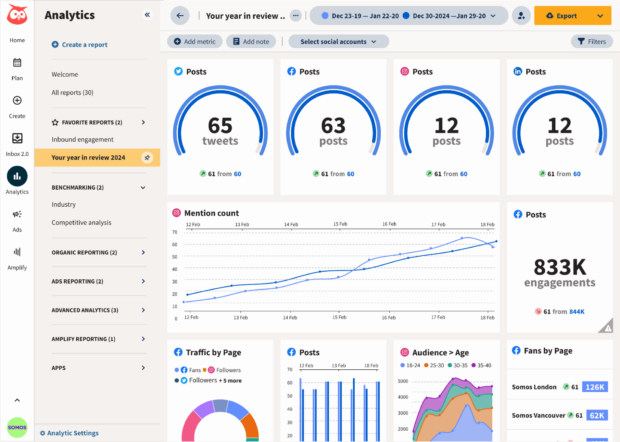
Hootsuite is a particularly useful tool for social media SWOT analysis. It gives you a clear picture of your social results across platforms, all on one screen.
This side-by-side comparison shows which social tools are working best for your brand. You can confidently identify your strengths and weaknesses.
The industry benchmarking tool shows how your results compare to the industry average. And the competitive analysis feature measures your results against up to 20 competitors of your choice.
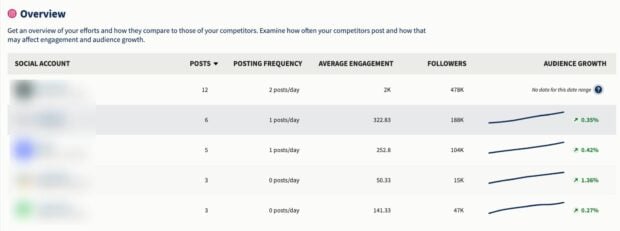
In addition, Hootsuite Listening is an industry-leading tool for detailed social sentiment analysis, social listening, and competitive intelligence. You can track what people are saying about you, your top competitors, and your products. These detailed analyses help you identify specific opportunities and threats as they emerge.
2. Meta Business Suite
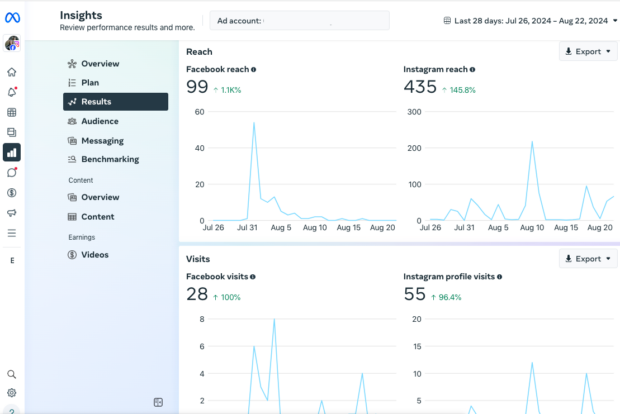
Source: Meta Business Suite
The native analytics tools within Meta Business Suite give you a picture of your social media results on Facebook and Instagram.
This can help you understand which of these platforms is working best for your brand right now. You can also see how your results differ across surfaces within the platforms. This helps identify specific strengths and weaknesses for your social media SWOT analysis.
You can get into some external factors here too with basic benchmarking features. Just keep in mind that Meta Business Suite only provides data for Meta properties. You’ll need separate tools for other platforms and social listening.
3. Sprinklr
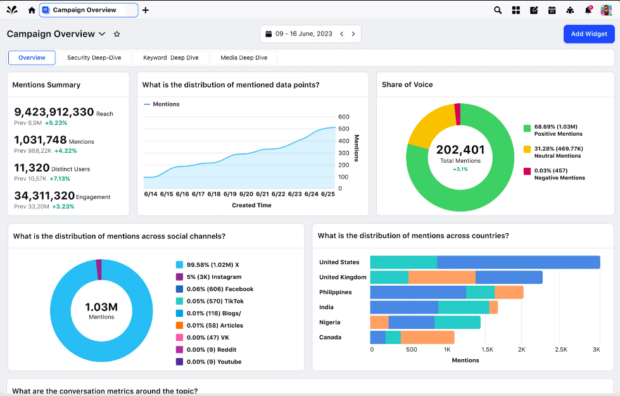
Source: Sprinklr
Sprinklr offers solid social media analytics and customer insights. These help you complete the strengths and weaknesses portions of your social media SWOT analysis. Brand monitoring and competitive intelligence reports provide details useful in completing the opportunities and weaknesses assessment.
Sprinklr offers social listening capabilities to help you identify important trends. However, the inputs are limited compared to Hootsuite’s 130+ million sources and 30+ social media channels. Sprinklr plans start at $299 per user per month.
See how Sprinklr compares to Hootsuite.
Save time managing your social media presence with Hootsuite. Publish and schedule posts, find relevant conversions, engage your audience, measure results, and more — all from one dashboard. Try it free today.
All your social media analytics in one place. Use Hootsuite to see what’s working and where to improve performance.
The post Social Media SWOT Analysis: How to Dig Up Impactful Insights appeared first on Social Media Marketing & Management Dashboard.





I really appreciate your exploration of SWOT analysis in the context of social media strategy. It’s fascinating how a concept that has endured since the 1960s continues to provide value in our rapidly changing digital landscape. I often think about the dual nature of social media platforms—while they can amplify a brand’s voice, they also introduce potential pitfalls that companies need to navigate carefully.
I completely resonate with your thoughts on the dual nature of social media platforms. It’s intriguing how they serve as both a megaphone for a brand and a minefield of potential risks. On one hand, brands have unprecedented access to audiences, allowing for authentic engagement and the cultivation of communities. On the other hand, a single misstep can lead to backlash that seems magnified by the very same platform that amplifies positive messages.
I completely agree with you about the enduring relevance of SWOT analysis, especially in the ever-evolving realm of social media strategy. It’s interesting to consider how a tool developed for business strategy has found such a seamless application in the digital world. The dual nature of social media is indeed a double-edged sword; on one hand, it offers brands an unprecedented platform for authentic engagement, while on the other hand, it can expose them to rapid scrutiny and backlash.
You’ve touched on a crucial point about the dual nature of social media. It’s almost like a double-edged sword. While brands can engage directly with their audience and create genuine connections, they can also face significant backlash if there’s a misstep or miscommunication.
Thank you for your thoughtful insights! If you’re interested in diving deeper into effective strategies for navigating the complexities of social media, check out this resource that complements the ideas we’ve discussed.
https://localseoresources.com/ninja
The concept of a SWOT analysis is fascinating, especially how it applies to the rapidly evolving landscape of social media. I’ve found that conducting a SWOT analysis not only illuminates the strengths and weaknesses of your current strategy but also opens up a dialogue about how external factors can shape your approach. For instance, when I recently did a SWOT analysis for my own social media initiatives, I discovered that while we had strong audience engagement (a strength), there were emerging platforms that our target demographic was migrating to (an opportunity that we needed to explore).
I appreciate your insights on the SWOT analysis in the context of social media. It’s interesting how that framework really encourages a proactive rather than a reactive mindset. You mentioned strong audience engagement as a strength, which is fantastic—it often serves as the backbone of any successful strategy.
“Discover insights that could transform your perspective—explore more here!”
https://localseoresources.com/ninja
It’s interesting to hear how a SWOT analysis has shaped your understanding of your social media strategy. Your point about audience engagement being a strength while recognizing emerging platforms as an opportunity is spot on. The landscape is always shifting, and keeping an ear to the ground can really help in adapting your approach.
“I’m glad to hear your insights on SWOT analysis in the context of social media! If you’re looking to dive deeper into how to effectively leverage your findings for optimal strategy, check out this resource that offers practical tips and tools.”
https://localseoresources.com/ninja
I love how you highlighted the timeless nature of the SWOT analysis in social media strategy! It’s fascinating to think about how a framework developed in the 1960s can still be so relevant today. I’ve found that leveraging this analysis not only helps in identifying specific strengths and weaknesses but also sparks creative brainstorming sessions within the team.
It’s fascinating to see how the SWOT analysis, a tool that has stood the test of time since the 1960s, has found its place in the fast-paced and ever-evolving world of social media marketing. The way you’ve highlighted its importance in creating a structured approach to evaluating social media performance really resonates with me. I often think about how the principles of strategic planning, like those encapsulated in SWOT, can sometimes feel overshadowed by the constant push for immediate engagement and viral content.
It’s interesting to see how a tool like SWOT, which feels so rooted in traditional business strategy, is still so relevant in the rapidly changing world of social media. I’ve personally found that conducting a SWOT analysis for my own social media efforts has really helped to clarify priorities. For instance, identifying specific strengths, like a highly engaged audience, can give you the confidence to explore more ambitious campaigns.
I found your exploration of SWOT analysis in the context of social media strategy quite enlightening. It’s fascinating to think about how this tool, which has its roots in the 1960s, remains so relevant today, especially as marketing increasingly intersects with technology. Your emphasis on the importance of evaluating both internal and external factors really resonates with me.